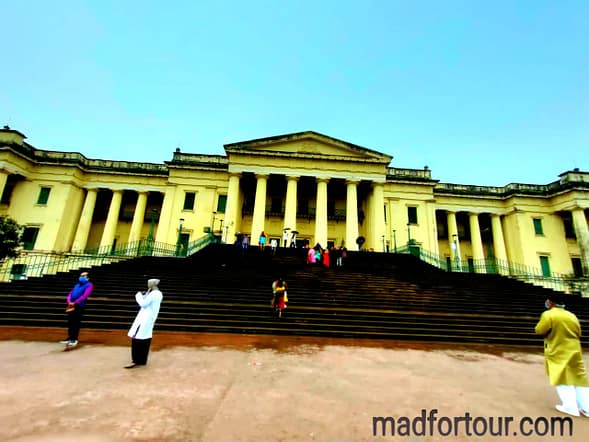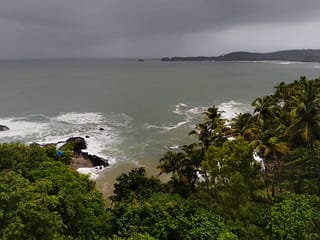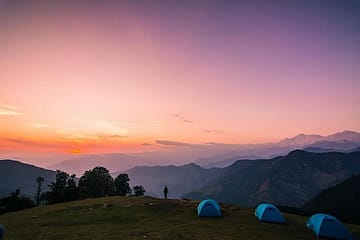Hazarduari of Murshidabad is undoubtedly the most iconic attraction of Murshidabad. The huge yellow structure is located right next to the river Bhagirathi. Although Murshidabad is known to both Nawab Siraj-ud-Daulah and Hazarduari, and there are lots of places to visit in murshidabad.
During the period 1829-1837, Humayun Jah built Hazarduari on the site of the old fort known as Nizamat Qila (Fortress). Architect Duncan McLeod was the original planner of this huge building. Hazarduari is the finest example of Indo-Italian architecture with huge pillar.
A magnificent flight of stairs, beautiful statues and lampposts. Nawab Humayun Jah is believed to have spent (at that time) Rs 18 lakh for the construction of his palace.
places to visit in murshidabad in 2022
1)Yellow mosque in Hazarduari

hazarduari murshidabad
The palace has now been converted into a museum with antiques, weapons, armor and some priceless paintings by various European artists. Other interesting items include old clothes and jewelry, palanquins, ivory hawda and palanquins, great chandeliers and even some rare books.
Old maps and manuscripts. All of the museum’s antiquities are undoubtedly wonderful, but the most impressive is the grand chandelier with 96 lamps placed in the court hall. Inside the hall there is also a silver throne with a huge umbrella, this is the most iconic place to visit in murshidabad.
Hazarduari literally means the place of a thousand doors (a thousand means a thousand and a door means a door). The palace is said to have a thousand doors. However, only 900 of them are genuine and 100 are fake.
It will probably take you an hour or more to see the Hazaraduari Palace and its museum. And if you are a fan of antiques and history, you may need more time. The Hazarduari complex has the Clock Tower, Bachchewali Tope, Medina Mosque and Nizamat Imambara just opposite the Hazarduari.
also read: unique places to visit in Kolkata a budget friendly travel 2021
Hazarduari, Murshidabad Opening hours: 9am to 5pm.
Entrance fee: You will have to pay an entrance fee to enter the museum. The entrance fee for Hazarduari Palace and Museum is 5 rupees for Indians and 200 rupees for foreigners.
2)Nizamat Imambara

Nizamat Imambara at Hazarduari in Murshidabad
Nizamat Imambara best places to visit in murshidabad.
Just opposite the yellow building of Hazarduari Palace is the impressive Nizamat Imambara. In contrast to the blue sky, the white structure looks absolutely gorgeous. If you don’t believe, look at the pictures.
The present Imambara was built in 1847 by Nawab Nazim Mansur Ali Khan Feradun Jah after the original wooden Imambara built by Nawab Siraj-ud-Daulah was destroyed by fire. The Imambara is 680 feet long and the central block is about 300 feet wide. Nizamat Imambara is the largest in Bengal and one of the largest in India.
Unfortunately, Nizamat is not allowed to enter Imambara. Imambara is open to visitors only for 10 days during Muharram.
also read: Princep Ghat Kolkata, History and contributions of James Prinsep
3)Katra Mosque
Katra Mosque the best places to visit in murshidabad
Katra Mosque is probably one of the oldest structures in Murshidabad. It was built by Nawab Murshid Quli Khan between 1723 and 1724. The Katra Mosque was a major center of Islamic learning. As soon as you enter the Katra Mosque, you will see two towers on either side. In fact 4 of them were in four corners, but the other 2 were destroyed in the 1897 earthquake. There is a flight of stairs through which one can reach the top of the tower. But now the gates have been closed.
In the middle of the two towers you will find small cells. These houses are found on 2 floors around the mosque. It is said that these cells were used in the homes of the scholars who came there for Islamic teachings. There are about 700 cells around the structure.
The next interesting structure is the mosque itself. Katra Mosque has 5 doors. There are three mihrabs on the wall facing the door of the mosque. The mihrab indicates a semicircular niche on the wall of a mosque. It points in the direction of the Kaaba in Makkah. Muslims look at this and pray.
also read: Srinagar to Leh distance and places to visit in Leh in 2021
4)Mihrab in Katra Mosque, Murshidabad
Above the central mihrab is an Arabic inscription. The central mihrab has a small staircase leading to a small platform. This is the platform where advice and lectures are usually given. This is exactly what we saw at the Adina Mosque in Malda. The platform there was much higher though.
On the outer wall of the mosque is a basalt slab with some Persian inscriptions. Huge prayer place in front of the mosque. It is said that the place of prayers can seat 2000 prayer readers. You can actually see the prayer area divided into floor squares.
It is said that there are 2000 squares, each for the prayer reader. There are also a few hooks on the walls of the mosque and a few rings on the floor of the prayer place. Our guide told us that the hooks and rings were used to tie huge clothes so that they could act as a canopy over the prayer readers during the sun and heat.
This is not the end of Katra Mosque. There is also the tomb of Nawab Murshid Quli Khan. The current entrance to the mosque is actually the back entrance. The main entrance to the mosque is now at the back (east side). There are fourteen flights of stairs to enter the mosque.
Below the stairs is the tomb of Nawab Murshid Quli Khan. It is said that the Nawab felt remorse for all the bad things he had done in his lifetime towards the end of his life. So he wanted to be buried under the steps of Katra Mosque so that the dust of the feet of the aristocracy would fall on his grave. It will be a way to atone for his sins.
5)Tomb of Murshid Quli Khan at Katra Mosque, Murshidabad

Katra Mosque
Although Murshidabad is known for most of the Hazarduari, it is the Katra Mosque that we find most interesting. The structure, architecture and story of Nawab Murshid Quli Khan were quite captivating. Hazarduari in Murshidabad is undoubtedly iconic, but it is the Katra Mosque that was my heart!
also read:
6)Fauti Mosque
Fauti Mosque or Futi Mosque the best places to visit in murshidabad
Fauti or Fauti Mosque is another impressive structure in Murshidabad. It is a huge structure, but eroded by vegetation. The mosque was built in 1740 by Nawab Sarfaraz Khan, grandson of Nawab Murshid Quli Khan, but it was never completed. The mosque is located about a kilometer from the Hazarduari in Murshidabad, near the railway. There are some interesting stories surrounding the mosque.
The Fati Mosque is an incomplete work. Out of 5 domes, only 2 domes were built. The rest was never made. Also, no one prayed in the mosque. This was called the failed mission of Nawab Sarfaraz Khan. Historically, Nawab Sarfaraz Khan was shot dead by Alivardi Khan in the battle of Giria in 1740, the year the mosque was built. Construction of the mosque was stopped after his death.
also read:Taki Hasnabad best weekend destination near Kolkata within 100 kms
7)The hole in the footy mosque
There is another interesting story about the death of the Nawab which is more than a local legend. It is said that the Nawab was killed by lightning, not by gunfire on the battlefield. According to legend, when he died on the battlefield, the mosque was also struck by lightning.
This causes large cracks in the dome. Thus the mosque was considered unfortunate and the work was abandoned altogether. Well, in fact, after the death of the Nawab, the construction of the mosque was stopped due to lack of funds. The story of the thunderbolt is probably a funny story to surprise people.
There is also a third story that is told more as an interesting folktale. It is said that the Nawab ordered the construction of the mosque in one day. The masons could not get the job done and were thus abandoned. This story is so stupid that even guides nowadays tell us that it is not true !!
However, the Fauti Mosque is an impressive structure. At first glance, it looks like any dilapidated structure. But once you go inside, you will see that it is quite beautiful. A small flight of broken stairs leads inside the mosque.
There are 5 entrances and 4 attached towers. As we have said before, only two domes have been completed. Well, if you decide to go up the stairs, be careful. It’s broken and slippery and I’m sure you wouldn’t like to fall from there.
We found the incomplete and eroded structure to be so attractive. We wondered what the whole structure would actually look like! This will undoubtedly be an achievement when the construction is completed!
7)Jahan kosha kaman the best places to visit in murshidabad
Jahankosha Cannon Murshidabad
The Jahankosh cannon is near the Katra mosque. Placed on a foot, the huge cannon weighs 8000 kg, is 17.5 feet long and is made of 8 metals. About 17 kg of gunpowder was used to make one shot. Not surprisingly, it was known as Jahankosh (Destroyer of the World). The area where the cannon is now located was known as the artillery. The cannon was made in 1637 by Janardhan Karmakar, a gunman from Dhaka. Nawab Murshid Quli Khan bought the cannon from Dhaka to Murshidabad while transferring his capital.
8)Tripolia Gate

Tripolia Gate Murshidabad
Tripolia Gate Murshidabad
The Tripolia Gate was one of the entrances to the Nizamat Qila (fort) area of Murshidabad. It now stands as a white gate with a nahabatkahan at the top. It is said that the Nawabs used to enter the Qila area on horseback through the Tripolia Gate. This gate was formerly known as Chalk Gate. The Chawk Mosque is a few meters away from the gate. The Tripolia Gate was built by Nawab Shuja Khan, the successor of Nawab Murshid Quli Khan.
also read: Kolkata to Darjeeling – How to reach Darjeeling by train bus or flight 2021
9)Wood gardens and palaces

Lion statue in the wooded garden of Murshidabad
Lion statue in the wooded garden of Murshidabad
The wooded garden is a vast area of gardens, palaces and temples in the center of Murshidabad, just like an oasis in the middle of a busy city. The complex was built by Roy Bahadur Laxmipat Singh Dugar, one of the leading bankers and zamindars of the early nineteenth century.
Well, as the name implies, there is no such thing as a wooden warehouse in the garden (Kathgola means a wooden warehouse). The name comes from “wood rose” which means wooden rose. Earlier many varieties of wood roses were grown in the garden hence its name Wood Rose Garden.
10)Entrance to the wooded garden of Murshidabad
The wooden entrance itself is huge and quite impressive. There is a large Corinthian pillar at the entrance, with a stucco flower design and a beautifully stained glass nahabatkhana. As soon as you enter through the gate, you will see a huge garden where there are mainly mango trees. If you look around, you will see 2 statues of a man on horseback on either side of the path. The statues are probably of Dugar brothers. Next to the entrance ticket gate.
After you enter the premises, the first thing that comes to mind is the baoli to your left. Baoliti was once in a very bad state but has now been reformed. Okay, this is just a stepwell and no secret path as a few guides would claim. There is a statue of a lion and a marble statue of a man. On the right, you will find a zoo. At one time it was a private zoo, but now it has lost its luster. We do not visit the zoo.
11)Marble statues of people in the wooded garden of Murshidabad
Next, comes the grand 3-story palace with a pond in front. Go to the other side of the pond and you will find beautiful pictures of the palace and its reflection in the water. This palace is a beautiful example of fusion architecture that was so prevalent at the time.
The palace has now been converted into a museum and contains marble statues, huge chandeliers, Italian marble, porcelain utensils, old rosewood furniture, Belgian mirrors, paintings and other antiques. Unlike Hajaduari, it is not allowed to take pictures inside the palace.
Reflection of wooden palaces in the pond – Murshidabad Tour Guide
12)Zenana Mahal inside the wooded garden
Another dilapidated building stands a short distance from the Yellow Palace. It was Zenana Mahal or Women’s Mahal. A short walk away at one end of the garden is the beautiful Adinath temple dedicated to the first Jain Tirthankara. The temple was built in 1933, when the statue is said to be about 900 years old. There is a pond in front of the temple where you can go boating.
Adinath temple inside Kathgola
Ticket price: Rs 50
The wooded garden is a huge complex. Be prepared to wander around a bit. I would recommend you to wear comfortable shoes to visit these places.
13)Home of Jagat Seth and Pareshnath temples

Pareshnath temples
Jagat Seth’s house
Jagat Seth was the title of the mad rich merchants of the area, who were also financiers of the Nawab and other zamindars. This was the title given to the descendants of Manik Chand, who came to Murshidabad from Rajasthan for business. In 1715, Manik Chand, the Mughal emperor of Farrukhsia, was given the title of “Nagar Seth (Banker of the City)”.
After the death of Manik Chand, his nephew Fateh Chand succeeded him and achieved much success. In 1723, the Mughal Emperor Mohammad Shah gave Fateh Chand the title of “Jagat Seth” (World Banker).
After Fateh Chand, his grandson Mahtab Chand received the title in 1844. His cousin Swarup Chand was given the title “King”. They were both the biggest financiers of the time. They were instrumental in the defeat of Siraj-ud-Daulah at the battle of Palashi.
Jagat Seth is said to be the pioneer of banking in India. There are many stories about the wealth of Jagatsheths. They financed not only the Nawab but also European and other feudal lords.
Pareshnath temples
There is a funny thing about Jagat Seth’s wealth. It was thought that if they poured their wealth into the Bhagirathi river, the abundant wealth of Jagatsheth would be blocked! Robin Orme, the official historian of the British East India Company, described Jagat Seth as the greatest banker and money changer in the world at that time.
The present building, now known as Jagat Seth’s house, was probably their banking courtyard. The original house has been swallowed up by the changed flow of the river Bhagirathi. The house has now been converted into a museum. Here, too, you can get a guided tour of the museum where you can see antique furniture, coins, utensils and vintage clothing.
There is Pareshnath temple in the courtyard of Jagatsheth’s house
14)Tomb and mosque of Azimunnisa Begum
Tomb of Begum Azimunnisa
Azimunnisa Begum has a thrilling history. The place seemed beautiful to us, but the story was a little hard to digest. Begum Azimunnisa was the daughter of Nawab Murshid Quli Khan and is believed to have been a nymphomaniac. We have no problem with that, but the story goes that he ate the liver of the children. Begum once had a fatal disease.
He was advised to eat the liver of newly slaughtered children as a remedy. but did so and recovered, but for Begum it became an unhealthy habit. did not close the child’s liver. That is why she was known as Kalija-Khaki Begum. was later buried alive for his misdeeds.
We don’t know if we will actually believe the story. We leave it up to you to decide. But the tomb of Begum Azimunnisa, like her father Nawab Murshid Quli Khan, is located at the foot of the entrance.
15)Salt is forbidden the best places to visit in murshidabad
Salt is forbidden the best places to visit in murshidabad
Namak Haram Deuri is actually the dilapidated gate of Mir Jafar’s palace. Now there is nothing left of the palace. It is believed that Mir Jafar’s son Miron Siraj-ud-Daulah was stabbed to death under this gate. There is another story that Siraj was actually killed in Hira Lake Palace. After the death of Nawab Siraj-ud-Daulah, Hira Lake Palace was also completely destroyed.
According to popular belief, Nawab Siraj-ud-Daulah was betrayed by his own relatives and men and so he lost to Robert Clive despite having more military power than the British. Mir Jafar betrayed the Nawab. From then on, the gate of his palace became known as Haram Deuri or Traitor Gate.





2 Comments
Clemencia Kopriva · July 30, 2022 at 7:16 am
Saved as a favorite, I love your blog!
Tom Rotner · August 9, 2022 at 11:55 pm
There is definately a lot to know about this topic. I really like all the points you’ve made.